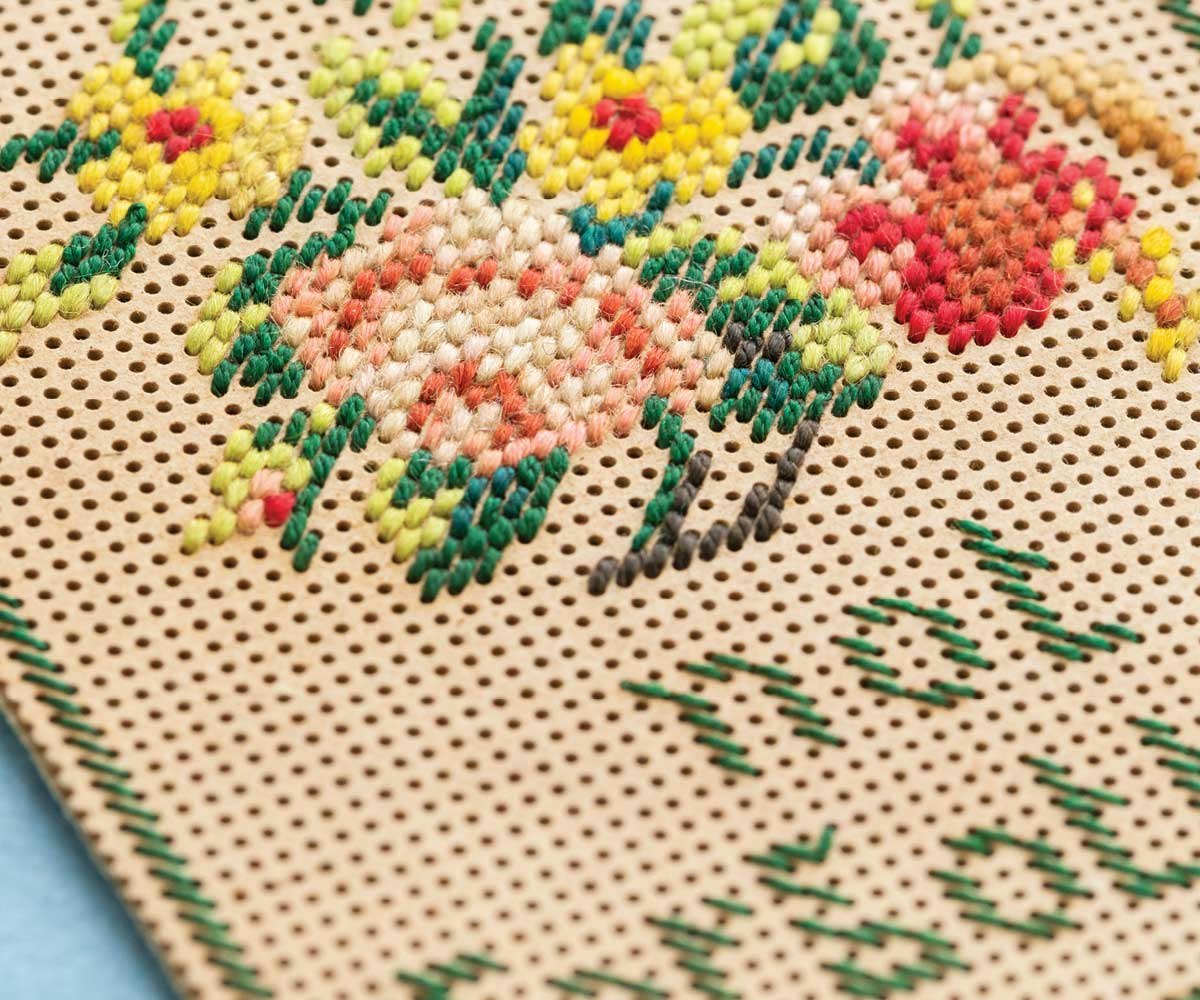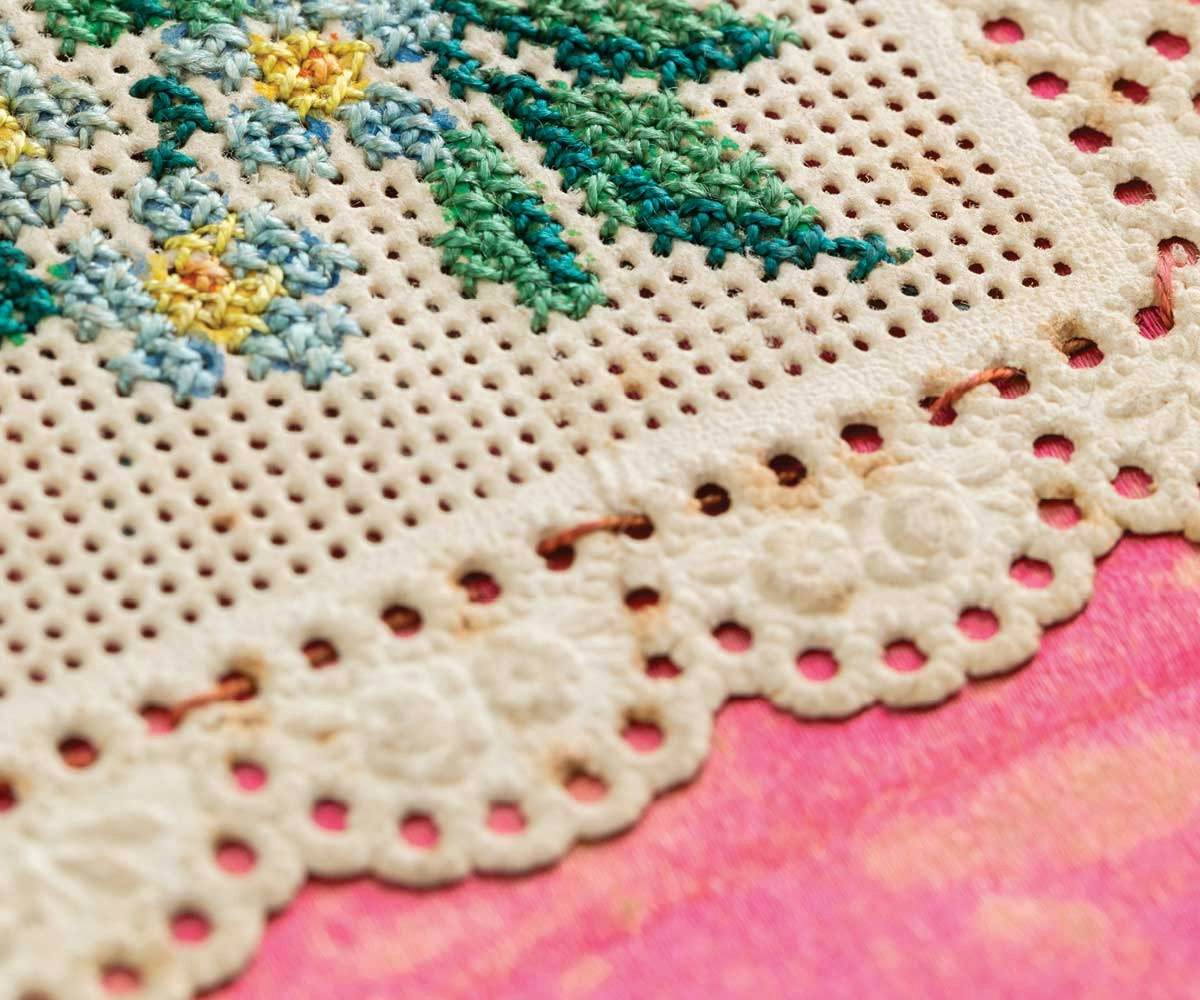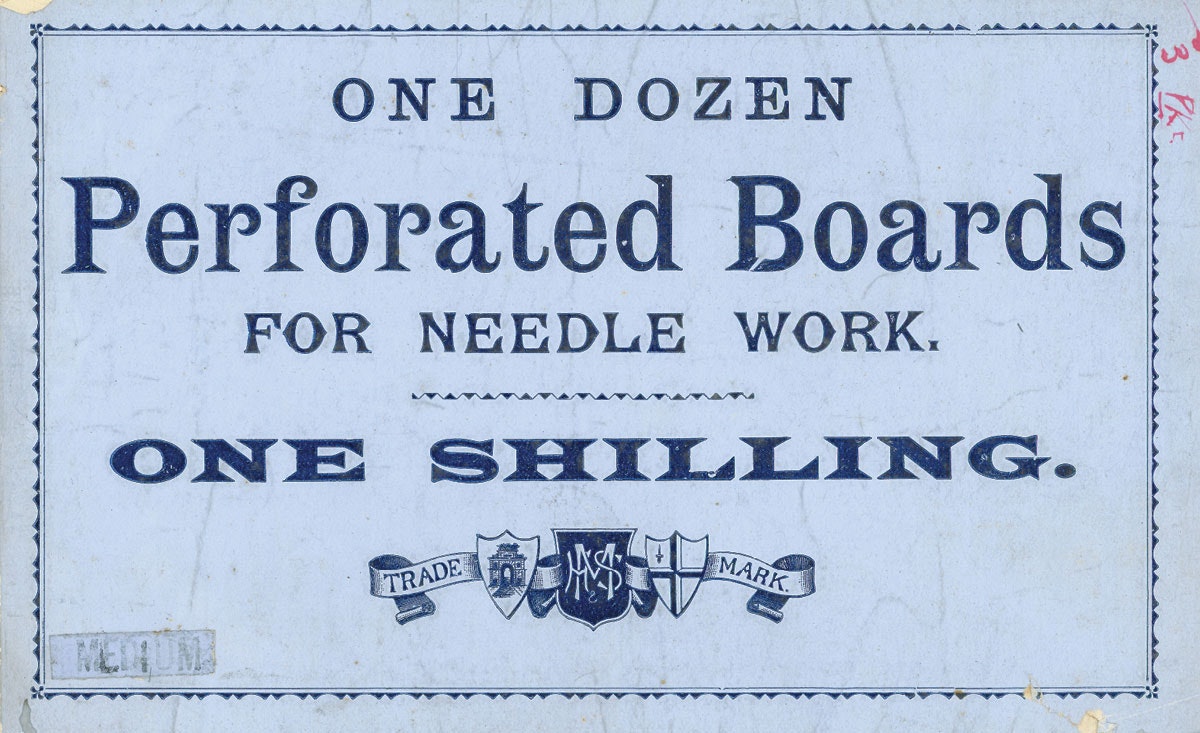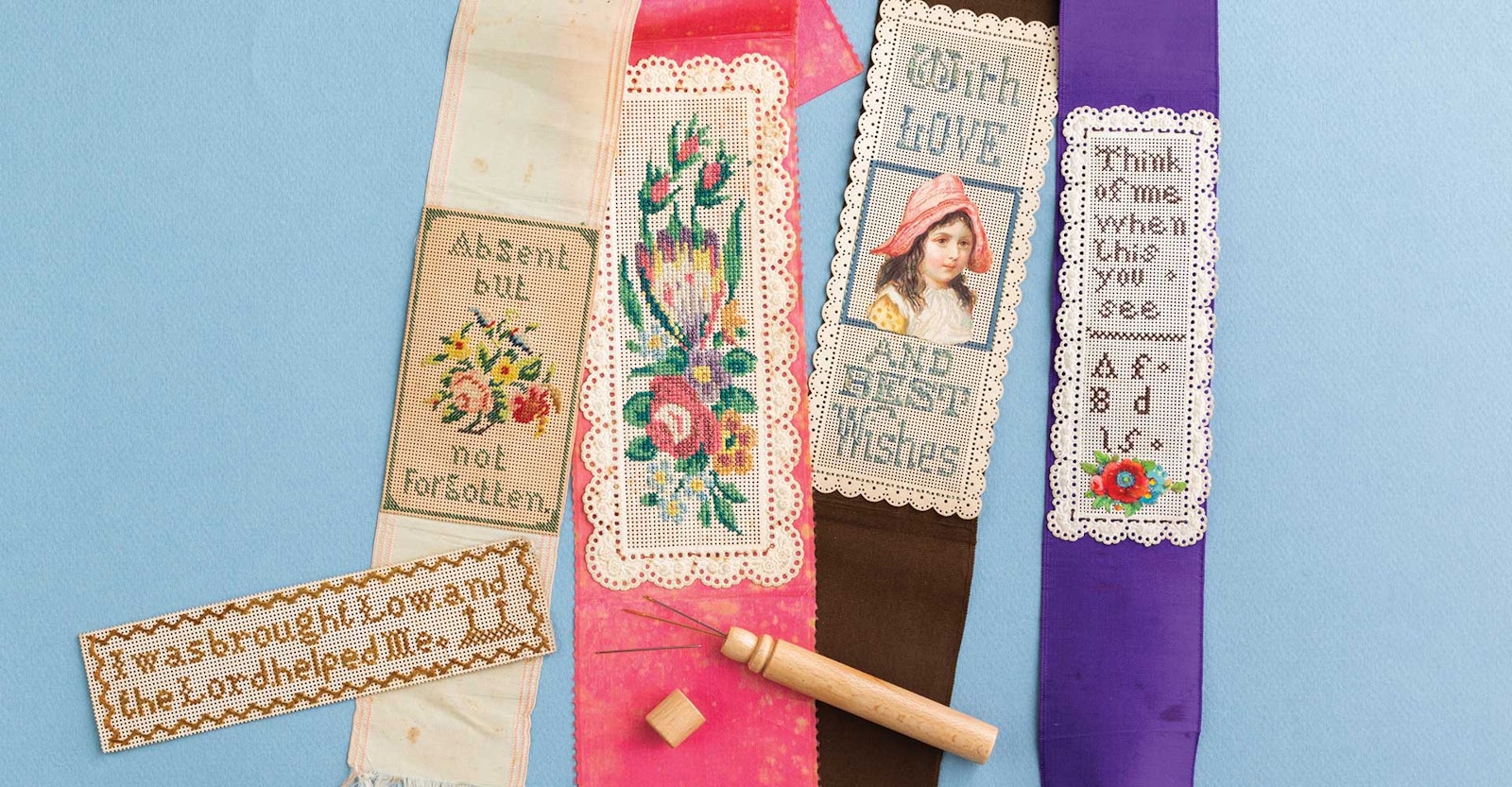https://pieceworkmagazine.com/cdn-cgi/image/format=auto/https://www.datocms-assets.com/75076/1656656836-forget-me-nots-1.jpg?auto=format&w=900
For centuries, stationery and paper goods played an important role in the social life of European society. Stationery stores brimmed with the products needed to meet the high standards of proper etiquette. This abundance ranged from visiting cards, greeting cards, pocket almanacs, lace paper, and embossed envelopes to myriad supplies for making one’s own tokens of affection. Tiny paper flowers, miniature paintings, die-cut scraps, and even dried moss or small shells could be added to intricately embossed, and sometimes silvered, paper backgrounds.
So, it is not entirely surprising that thick paper, or card, was attempted as a ground material for hand embroidery—an important skill for every Victorian lady. Paper proved to be suitable; however, it was used a lot less often than traditional fabrics, such as silk, linen, cotton, batiste, and others.

Cross-stitch and half cross-stitch were common stitching techniques used on perforated paper.
[PAYWALL]
Paper, Pins, and Needles
The Victorian interest in embroidery on paper was preceded by another popular paper craft. In the late eighteenth century, pin pricking was used to embellish cards and watercolor art. The artwork was first painted on paper, then its outline was carefully traced on the back and pricked through front or back with different sizes of pins or needles. The raised, pin-pricked lines in such pictures resembled embroidery stitches and trapunto quilting. It seems that perforated paper, which would also be called perforated cardboard or punched paper, was devised to meet ladies’ interest in stitching on paper.
One very early example of perforated-paper needlework is mentioned by John F. Meginness, an American of Irish descent from Williamsport, Pennsylvania, in his genealogy book, Origin and History of the Magennis Family. Describing the country life of one of his ancestors, James McGinness, and the man’s first wife, Ann Fordham, an English Quakeress from Philadelphia, he writes, “A specimen of her needle work is still in existence. It consists of a few mottoes or verses worked on perforated card board with colored yarn, with her name, ‘Ann Fordham’, and the date ‘1775’, attached.”
A woman living in the nineteenth century was expected to have excellent stitching and sewing skills to run her household. Young girls learned plain and fancy needlework at home or in school. Since stitching on perforated paper was easier and more economical than working with fabric, it was an excellent choice for children and beginners. Using a paper foundation required patience and attentiveness to stitching in order not to tear the paper, building character traits commended in the Victorian era. Such childhood paper samplers are rare to find, whereas their fabric-based counterparts survived the passage of time in greater numbers.
Mid-Nineteenth Century Paperboard
The invention of perforation machines in the 1850s allowed for the production of perforated paper in mass quantities. Once it became available at reasonable prices, perforated-paper needlework and crafts flourished into a phenomenon of “perforated card-work.”
Perforated paper was a thick, pliable, high-rag content paper with small perforations at regular distances and a smooth finish on the top side. These paper goods were intended for embroidery and came in several stitching sizes, from as few as 8 holes per inch to as many as 32. In 1876, the Hope Perforating Company’s advertisement in The Publishers’ Weekly offered a selection of perforated cardboard in five sizes: “. . . No.1, Fine, No.2, Medium, No.3, Coarse, No.4, Medium Coarse, No.5, Extra Coarse.”
The most common color of perforated paper was white, and it was sold in packages containing sheets in various sizes and quantities. An English package from my collection contains one dozen fine-grade, rectangular sheets priced at one shilling. But paperboard came in many colors; The American Girl’s Book lists blue, green, pink, lilac, and yellow as choices for a card needle-book project. The most expensive perforated paperboard was metallic silver and gold.
Perforated paperboards were advertised in catalogs and fashion periodicals from the 1840s to about 1900. Several American monthly magazines for middle- and upper-class women, such as Godey’s Lady’s Book and Magazine, Demorest’s Monthly Magazine, The Peterson’s Magazine, and The Harper’s Bazaar, regularly published step-by-step instructions for perforated card-work projects. They almost always included an illustration of the finished piece as a visual aid to the project description.
The higher-count board with more densely placed holes was recommended for small pieces stitched with silk, such as bookmarks and cards. Lower-count paper was considered more suitable for large mottoes worked with wool. Victorian shops carried an impressive array of silk flosses, fine wools, glass beads, bullion, metallic, and chenille threads that could be used for such projects.

Fancy edgings were common on period bookmarks and cards.
Perforated-Paper Embroidery Projects
Everyday objects made from perforated paperboard included boxes, baskets, calendars, three-dimensional needle books, crosses, scented sachets, pincushions, stamp books, wall pockets, and even lampshades and tiny houses. But by far the most popular embroidered creations were bookmarks, cards, and religious mottoes.
Bookmarks were cut in rectangular shapes from sheets of perforated paper. They were embroidered with silk threads and attached to a silk or satin ribbon with a few inconspicuous stitches. Some were plain, with single words, names, or sentiments stitched in one color. Some were fashioned as single-motif samplers, with religious quotes or pictures adapted from Berlin wool-work patterns popular at that time. Occasionally, the entire phrase was beaded in silver or gold metal beads. The border was either left unfinished or cut into delicate shapes with a sharp pen knife. Paper lace edging was particularly striking when placed on a colored background. Perforated paper lace turned into a hobby of its own; it still exists today in a form of paper lace cutwork and carton perforé paper craft.
Back in their heyday, fancy bookmarks and sewing cards with perforated borders were sold by the specialty stationery stores. The bookmarks came in countless shapes and sizes; the Hope Perforating Company’s advertisement mentions sixty-five bookmark designs in four sizes. Commercially produced bookmarks were highly decorative: an embossed, die-cut scene on the left side or on both the left and the right edges, and a rectangular or an oval high-count stitching area in the middle surrounded by a relief border.
The scenes were usually pastoral or religious in nature: cupids, shepherds, children with lambs, and courting couples just to name a few. The embroidery was done in cross-stitch, half cross-stitch, long stitch, and buttonhole stitch. By the 1870s, innovations in the printing industry allowed printing on perforated paper. Bookmark manufacturers began stamping popular designs on their products to make them more attractive to the buyer.
Perforated stitching cards came mostly in four shapes: rectangular, oval, round, and octagonal. They had perforated centers for embroidery or solid centers for drawing and inscriptions. Sometimes they were embossed with an image of a flower or an animal in the middle of the card, and it could be colored for a quick and attractive artistic result.
Perforated cards were also used to make small objects, such as needle cases, by joining them together with a narrow silk ribbon. One such project assembly is described in The American Girl’s Book: “Take two handsome coloured cards with perforated edges. You may get them at the fancy stationers’. Prepare a double leaf of a square of white cassimere. Scollop [sic] the edges with scissors, or overcast them with sewing-silk. Lay these needle-flaps between the two cards, and bind all together at the back with narrow ribbon. Sew to each corner a string of the same ribbon, to tie up the needle-book when not in use; and put a bow at each extremity of the back.”
Perforated paperboard with 14 to 16 holes per inch (2.5 cm) was primarily used to make large mottoes. They were so common that many can still be found in homes today. Two prevalent sizes for mottoes were 8½ by 21 inches (21.6 × 53.3 cm) and 17 by 21 inches (43.2 × 53.3 cm). These large sheets could be purchased blank or preprinted with common phrases such as “Welcome,” “Home Sweet Home,” and “God Bless Our Home” or biblical scriptures. Mottoes were worked in tent stitch with variegated wool, but the background was left unstitched. A precut, slightly crinkled tinfoil was placed behind the finished work to add a sparkle of light.
Toward the end of the nineteenth century, white celluloid shapes, such as angels, were sold as motto embellishments. Mottoes were displayed framed, usually in rustic-style wooden frames backed with a wooden board. Unfortunately, the oils from the backing tended to leach into the paper over time, resulting in damage that looks like a water stain in many antique mottoes.

From the collection of the author. Photo by Irina Stepanova
Twentieth Century
Perforated-paper needlework began to decline after the death of Queen Victoria in 1901 and virtually disappeared by the 1920s. In the early 1900s, many perforated bookmarks were preprinted with phrases or designs. They were often left unstitched, with chromolithographic die-cuts or dried flowers glued to them as decorations instead.
In recent years, perforated-paper stitching and crafts have made a comeback. The company Tokens and Trifles revived perforated sewing cards but sadly closed their business in 2015. Luckily for those interested in continuing this Victorian needlework tradition, Wichelt Imports’ Mill Hill perforated paper has thirty colors available in 14- and 18-count for stitching and crafts.
Advice from the Past
The Ladies’ Self Instructor (1853) advised that for perforated cards, “The needles must not be too large, or the holes will be liable to get broken. The smaller ones must be worked in silk; the larger patterns may be done either in silk or wool. Sometimes the flowers are worked in Chenille, and the leaves in silk; this gives to card cases, &., a beautiful and highly ornamental appearance.”
Cassell’s Domestic Dictionary (1884) suggested uses for card-work including “. . . pretty frames for photograph frames . . . useful bookmarkers and ornaments for frames bearing a resemblance to carved ivory. . . Many little articles can be made of this cardboard which can be ornamented by needlework devices in silk or wool, or by gumming on painted flowers or figures.”
Resources
Cassell’s Domestic Dictionary: an Encyclopædia for the Household. London, Paris & New York: Cassell, Petter, Galpin & Co., 1884.
The Ladies’ Self Instructor in Millinery and Mantua Making, Embroidery and Appliqué, Canvas-Work, Knitting, Netting, and Crochet-work. Philadelphia: J. & J. L. Gihon, 1853.
Meginness, John F. Origin and History of the Magennis Family. Williamsport, Pennsylvania: Heller Bros.’ Printing House, 1891.
Leslie, Eliza. The American’s Girl Book: or Occupation for Play Hours. New York and Boston: C.S. Francis and Company, 1857.
Irina Stepanova is a designer, collector, and owner of Mishutka Design Studio (www.mishutkadesign.com). She writes about Victorian embroidery and lifestyle, and her projects and embroidery designs are a tribute to nineteenth-century women’s needlework.
This article was published in the Spring 2020 issue of PieceWork.




